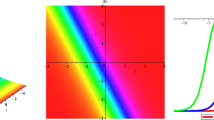Abstract
In this paper, the propagation of an electromagnetic pulse due to the interaction of laser pulse and plasma was investigated using a set of fluid relativistic equations and Maxwell’s equations in an unmagnetized collisionless common plasma. Using the multiple scale perturbation approach, the dispersion relation and the group velocity were derived, and finally it was shown that the evaluation of the components of vector potential is governed by two coupled-nonlinear Schrödinger (NLS) equations. It should be noted that using the relations of the phase and group velocities we understated that they are independent from plasma parameters. Then, using analytical methods, the solutions of the amplitude of the coupled Schrodinger equations for both components of the vector potential were obtained. Analytically, the modulation instability conditions in terms of plasma parameters have been investigated. Finally, by plotting the figures, the modulation stability and instability regions are numerically studied.




Similar content being viewed by others
Data availability
The supportive data of the present research are available from the corresponding author upon reasonable request.
References
P. Grelu, Opt. Commun. 552, 130035 (2024)
D. Strickland, G. Mourou, Opt. Commun. 56, 219 (1985)
Y. Lei, G. Shayeganrad, H. Wang et al., Light Sci. Appl. 12, 74 (2023)
A. Abdikian, S. Ismaeel, Eur. Phys. J. Plus 132, 368 (2017)
A. Abdikian, B. Ghanbari, Results Phys. 48, 106399 (2023)
V. Malka, J. Faure, Y.A. Gauduel et al., Nat. Phys. 4, 447 (2008)
A. Pukhov, Nat. Phys. 2, 439 (2006)
C. Labaune, Nat. Phys. 3, 680 (2007)
P.-T. Qian, X.-B. Zhang, C. Jiao et al., Phys. Plasmas 30, 012106 (2023)
J. Borhanian, I. Kourakis, S. Sobhanian, Phys. Lett. A 373, 3667 (2009)
J. Liu, H. Lu, H. Lu et al., Phys. Plasmas 30, 113103 (2023)
H. Demiray, A. Abdikian, Indian J. Phys. 95, 1255 (2021)
A. Abdikian, Phys. Plasmas 25, 022308 (2018)
A. Abdikian, M. Mohebifar, S. Raj, Mod. Res. Phys 5, 0 (2021)
G. Sánchez-Arriaga, E. Siminos, V. Saxena et al., Phys. Rev. E 91, 033102 (2015)
G. Sánchez-Arriaga, E. Siminos, J. Phys. A: Math. Theor. 50, 185501 (2017)
T. Taniuti, N. Yajima, J. Mathe. Phys. 10, 1369 (1969)
M. McKerr, F. Haas, I. Kourakis, Phys. Plasmas 23, 052120 (2016)
B. Rajabi, M. Mohammadnejad, Phys. Plasmas 30, 082112 (2023)
S. Roy, A.P. Misra, A. Abdikian, Phys. Fluids 35, 066123 (2023)
J. Borhanian, Phys. Lett. A 6, 595 (2015)
H. Demiray, A. Abdikian, Chaos Solitons Fractals 121, 50 (2019)
E. Fan, Phys. Lett. A 277, 212 (2000)
R. Hirota, J. Mathe. Phys. 14, 810 (1973)
S. Liu, Z. Fu, S. Liu et al., Phys. Lett. A 289, 69 (2001)
A. Abdikian, S. Sultana, Phys. Scr. 96, 095602 (2021)
B. Pradhan, A. Abdikian, A. Saha, Eur. Phys. J. D 75, 48 (2021)
M. Wang, X. Li, J. Zhang, Phys. Lett. A 372, 417 (2008)
I. Aslan, T. Öziş, Appl. Math. Comput. 209, 425 (2009)
A. Khare, A. Saxena, J. Mathe. Phys. 55, 032701 (2014)
E. Fan, J. Phys. A: Math. Gen. 35, 6853 (2002)
A. Abdikian, S.V. Farahani, Eur. Phys. J. Plus 137, 652 (2022)
A. Abdikian, S. Vasheghani Farahani, S. Hussain, Mon. Not. R. Astron. Soc. 506, 997 (2021)
Funding
No funding.
Author information
Authors and Affiliations
Contributions
All authors contributed equally to this work.
Corresponding author
Ethics declarations
Conflict of interest
We declare that there is no conflict of interest among the authors.
Additional information
Publisher's Note
Springer Nature remains neutral with regard to jurisdictional claims in published maps and institutional affiliations.
Appendix
Appendix
Substitute \(\xi =x-2pst\) and \(\tau =t\) in Eqs. (26) and (27) and considering
to obtain
Using the Jacobi elliptic function expansion method. One can assume \({A}_{x}\left(\xi \right)=\Phi \left(\xi \right)\) and \({A}_{y}\left(\xi \right)=\psi \left(\xi \right)\) as a finite series of Jacobi elliptic function (for example \(cn\)) and follow that method as [44,60]
where \(\varphi \) is considered as one of the Jacobi elliptic functions \(sn\xi \), \(cn\xi \) and \(dn\xi \). By balancing between the highest order linear term and the nonlinear of eq. (A–1), one will realize that the value of \(N\) should be \(N=2\). Hence, the (A–1) equation may have the following form travelling wave equation
Substituting eqs. (A–5) and (A–6) into (A–2) and (A–3), one can obtain
and by substituting \({cn}^{2}\zeta =1-{sn}^{2}\zeta \) and \(d{n}^{2}\zeta =1-{m}^{2}+{m}^{2}{cn}^{2}\zeta \), and with the aid of Mathematica we can determine the coefficients
where \(p\) and \(k\) are fixed and arbitrary values.
Rights and permissions
Springer Nature or its licensor (e.g. a society or other partner) holds exclusive rights to this article under a publishing agreement with the author(s) or other rightsholder(s); author self-archiving of the accepted manuscript version of this article is solely governed by the terms of such publishing agreement and applicable law.
About this article
Cite this article
Mohammadi, M., Sekhavat, N., Abdikian, A. et al. Investigation of the propagation of coupled laser pulses in a plasma. J. Korean Phys. Soc. 84, 610–617 (2024). https://doi.org/10.1007/s40042-024-01024-8
Received:
Revised:
Accepted:
Published:
Issue Date:
DOI: https://doi.org/10.1007/s40042-024-01024-8




